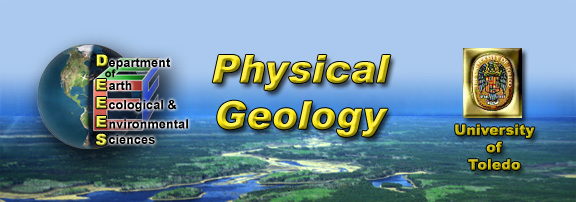

EEES 1010-004, Spring 2007, Dr. James Martin-Hayden
• Exploring Our Wonderful World
– Learning the materials that comprise our planet
– Investigating the processes that transform these earth materials and our environment
– Discovering how to read the earth and the history stored in the rocks
• A. Dr. Jamie Martin-Hayden
www.EEEScience.UToledo.edu/Faculty/Hayden/Default.htm
• Hydrogeologist studying groundwater resources and contamination (Environmental Geology)
• Special interest in the geology and hydrogeology of the Oak Openings Region
• Text: Essentials of Geology
• • Course Website
– Syllabus
– Homework Posting
– Other important Web Links such as
– 1. Geological Resources
– 2. “The Environment”
– 3. Geological Hazards
– 4. Astrogeology
– 5. Engineering
– 6. Landforms and Surface Processes
– 7. Artistic Inspiration
– The Cradle of Civilization sprung from geology of the region
– The Cradle of Civilization (Fertile Crescent)
– Development limited by availability, e.g., soil, water, energy
– Conflicts based on resources, e.g., water, minerals, oil…
– 1.7 billion are joining the consumer class and the environment won’t sustain this standard of living (Worldwatch Institute)
– Emissions of Greenhouse gasses is accelerating global warming
– Climate change is accelerating melting of glaciers and driving mass extinctions (The Centre of Biodiversity and Conservation, Leeds University, UK)
– Two die in 6.5 magnitude Earthquake near San Lois Obispo California
– Earthquake triggers mudslides
– A Magnitude 6.5 Earthquake hits a stone- and mud-house city of 100,000 in Iran 12-26-03
– 30,000 Dead
– 30,000 Refugees
– US sends aid and releases sanctions
– Relations improved
-Volcanoes
-Landslides
-Earthquakes
-Floods
– Geologists Study Mars
– Canyons indicate a geologically active planet
– Rock layers, Gullies, and Sand Dunes; all geological landforms
– The largest chasm and volcano in the solar system
– Glaciers
– Mass Wasting
– Streams
– Shorelines
– Deserts
– Ground Water
– Environmental Geology (see boxes)
• Environmental Sciences: how we influence the earth
• Geologic Hazards: how geology influences us (chapter 4, 9, 10, and 16)
– Engineering Geology
• Geologic Materials
• Foundations
• Geotechnical engineering
• Sub Disciplines (cont.)
– Geological Resources (chapter 21)
• Locating and characterizing amounts and quality
• Extracting geologic resources
• environmental effects
– Historical Geology (chapters 8 and 20)
• Deciphering Earth History and
• Evolution of life
– Astrogeology (See Boxes)
• Using our understanding of the earth to study other planets
• Objectives of Chapter 1
– Introduce the broad field of Geology
• Importance of understanding our planet
• Sub disciplines of geology
• How you might use geology (Box 1.3)
– Origin and Structure of the Earth
• Formation of the solar system (Box 1.5)
• Differentiation of the proto earth
• Zones of the Earth (Fig 1.7)
• Objectives of Chapter 1
– Earth processes and Plate tectonics
• Crustal plates and boundaries (pg. 14-16)
• Convection driving plate motion (Fig. 1.6)
• Geologic phenomena and landforms at plate boundaries
• Plate tectonics and the scientific method (box1.4)
• Internal Processes vs. Surface Processes (pg. 12, 16, 19)
– Introduction to the Geologic Time Scale
• Sequence of evolution events and
• general time spans
• World Physiography/Basic Geography
– Brushing up on basic geography will help you learn Plate Tectonics
• -Continents (6), -Oceans (4), -Seas (Mediterranean and Red),
• -Major Mountain Belts (N.A. Cordillera, Andes, Himalayas),
• -Major Island Arcs Philippines, Aleutian, New Zealand, Japan
– New places to learn: -Mid Ocean Ridges, -Oceanic Trenches
– Birth of the Solar System
– Nebular Theory
• Nebula compresses
• Flattening of spinning nebula and collapse into center to form sun
• Condensation to form planets, planetesimal, moons and asteroids during planetary accretion around 4½ billion years ago
• (Meteorites are iron-rich and rocky fragments left over from planetary accretion)
– The mass of the center of the solar system began nuclear fusion to form the sun
– The inner planets were hotter and gas was driven away leaving the "Terrestrial Planets"
– The outer planets were cooler and more massive so they collected and retained the gasses hence the “Gas Giants”
– The relatively uniform iron-rich proto planets began to separate into zones of different composition: 4.6bya
– Heat from impacts, pressure and radioactive elements cause iron (and other heavier elements) to melt and sink to the center of the terrestrial planets
– The uppermost mantle and crust are rigid solid rock (Lithosphere)
– The rest of the mantle is soft but solid (Asthenosphere)
– The Continental Crust “floats” on the uppermost mantle
– The denser, thinner Oceanic Crust comprises the ocean basins
– The Lithosphere is broken into “plates” (7 major, 6 or 7 minor)
– Plates that “ride around” on the flowing Asthenosphere
– Carrying the continents and causing continental drift
– Divergent
• Volcanic activity
– Fissure Volcanism,
– some volcanoes
– non-explosive, with “runny” lava
• Earthquake activity: Shallow earthquakes
• Physiographic features:
– In ocean basinsàMid Ocean Ridges
– Benieth continentsàContinental Rifting (splitting)
• See floor spreading
• Volcanic activity
– Steep sided Composite Volcanoes,
– Explosive with
– Gaseous lava
• Earthquake activity: Shallow to very deep
• Physiographic features:
– In ocean basinsàIsland arcs of composite volcanoes and adjacent oceanic trenches
– Benieth continentsàcontinental collision and mountain building
• See floor: Oceanic plate subduction spreading